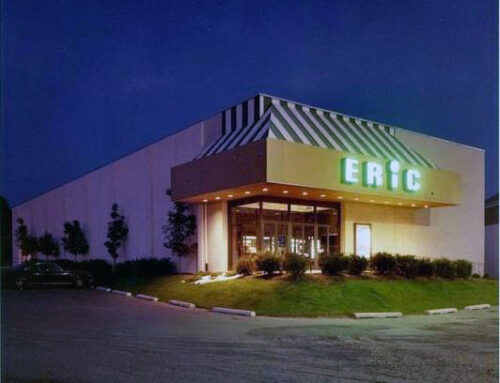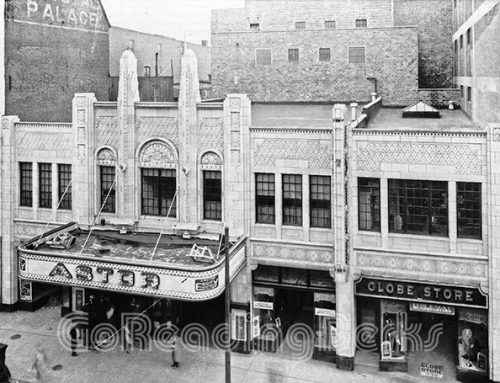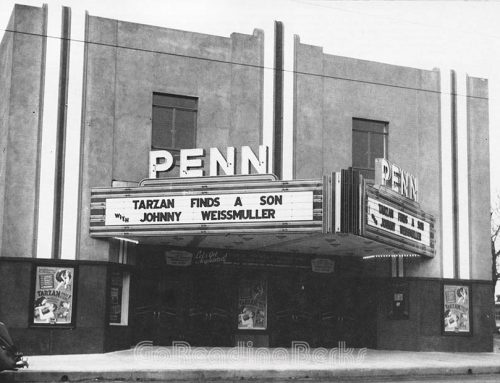The Embassy theatre was constructed on the properties owned by Ad. and Samuel Kutz and E. I. Kaufmann, 739-749 Penn Street, which at one time was the site of the Berks County House and the Bubp grocery store. Before the buildings were razed the lower floors had been occupied by Manegold Music House; the United Paint Up Stores; and the original Imber Bros, dry goods store. The top floor was occupied by the Chinese Restaurant. Built by Sidney Wilmer and Walter Vincent, this “million dollar house” would be the largest theatre in Reading with 2,460 seats.
Below: Berks County House, 1928.

Building was started in the Fall of 1930, by Charles Schlegel and Son, contractors, and Wm. H. Lee, architect.
Below: Construction of the Embassy.

As readers of the Reading Eagle opened their newspapers on April 4, 1931, they were greeted with the announcement that Reading’s newest theatre would be premiering that evening with a 7 P.M. showing of “Stolen Heaven,” featuring Nancy Carrol.

The opening ceremony was the sounding of reveille by the drum and bugle corps of the Haage Post and then veterans of Hunter Liggett and Greater Reading Posts hoisted the colors; the audience sang the national anthem, and the theatre was officially dedicated. About 8,000 people crowded 745 Penn Street in an attempt to be the first to view the splendor. Since the theatre’s capacity was reached within minutes of the opening, 4,000 patrons spent an hour touring the house before the early show, according to the edition of the Reading Eagle which hit the streets the day after the theatre’s premiere. In addition, nearly as many patrons filled the foyer and lined Penn Street waiting for the second show.
Below: The Embassy, 1957.

Below: 700 block of Penn Street, North Side, 1941.

The Embassy theatre was designed to carry out an atmospheric theme. The ornamental decorations included winged unicorns, chromium doors, balustrades and lighting fixtures, and display frames inlaid in black Italian marble. The blue ceiling with its indirect lighting and its graceful sweep was alluring. The theatre was built without a stage, but in its place there appeared a green terrace flanked by huge ornamental gates weighing several tons. Draperies and curtains were absent and the whole effect was one of a Grecian Garden with a terraced lawn stretching from the floor of the auditorium to the screen which offset the receding sky. The terrace was flanked by trees, shrubbery, fountains and columns, all designed with a modernistic touch. The screen was the latest and the largest designed for sound films while the booth contained the newest type of Western Electric equipment. Modernistic speakers were designed to reproduce the speaking and singing voice with a quality as fine as the best symphony orchestra. Patrons throughout the theatre sat in spring cushion opera chairs similar to those found in the loge sections of the Roxy and Mayfair in New York City. The carpeting in the Embassy was also modernistic and the heating and cooling plants were the latest in scientific systems. Everything operated electrically and was designed to be converted with ease to meet every requirement of the future (talkies, television, stage productions, etc). For the convenience of patrons, there was a unit of girl ushers, a nurse in the lounge, and a footman who arranged to have autos checked and driven to a nearby parking garage to avoid parking inconveniences. Theatre phones were also installed for the benefit of hearing impaired theatregoers. Those worried about safety could feel secure in the knowledge that this motion picture house was built with sufficient exits to vacate the building in two minutes if the need arose.
Below: Interior of the Embassy.

There was a spacious lounge and the exterior was the first to display neon lights. The vestibule was inlaid with rubber tile of assorted colors while massive aluminum doors banked the lobby whose walls were of black marble with aluminum trimmings. The artistic lobby display frames were of shadow box design. Ceiling mural paintings depicted the spirit of the motion picture – the newsreel, romance, comedy, and adventure.
Below: The Embassy, 1950s.

Easy stairways in the foyer led to the lounges, loges, and balcony. The lounge was elaborately furnished and surrounded with ladies’ rest rooms, men’s smoking rooms, public telephones, and a large check room. The main auditorium was similar to an amphitheater of old with the curving ceiling making a graceful sweep from one end of the auditorium to the other. In addition, the ceiling reflected the sky-blue hue of the heavens. Tiny electric stars once flickered in the ceiling and engineers had tried to perfect a cloud effect, using steam. However, the clouds evaporated and water droplets fell on surprised patrons.
The Embassy was designed primarily for screen entertainment but a few other attractions and screen personalities were periodically scheduled. For the week of August 14, 1933, Princess Serene, mentalist extraordinary, appeared; March 9, 1934, Ann Little, Paramount’s “Betty Boop,” and Pauline Comanour, character cartoonist, were featured; Will Osborne and his Band appeared the entire week of July 13; and Ernie Hare and Billy Jones, the “Happiness Boys” of radio fame, played week of December 13. Herman Miller and his Sylvanians also gave a concert program; and one of the outstanding events was the personal appearance of Amos ‘n’ Andy, radio stars, on February 7, 1935. A week later, February 14, Joe Penner and troupe (including the duck), packed the house to the doors. On August 14, 1935, Ramon Novarro, screen celebrity, was presented; Ramus II, mentalist, was billed the week of August 4, 1939; and on January 25, 1940, Gene Autry, famous singing cowboy star, played to overflow houses.
Frank O’Brien, the district manager for the Wilmer and Vincent circuit in Reading, was put in charge of the Embassy’s affairs. O’Brien managed the Embassy for two years until Paul E. Glase became resident manager in 1933. Although the theatre was designed for motion pictures, various stars did make appearances. On February 7, 1935, the Embassy played host to Amos and Andy and on January 25, 1940, Gene Autry rode in on Champion, the Wonder Horse.
The Embassy theatre continued under Wilmer and Vincent’s management until August of 1944; the firm thus completed 43 years of uninterrupted activities in Reading. At that time the entire circuit was absorbed by the Fabian Theatre Company, an organization operating 65 theatres in the New York territory. It was during the Fabian control that Jose Iturbi, celebrated Spanish concert pianist, appeared at the Embassy, November 29, 1944, and thrilled more than 2,300 concert lovers. This was the only occasion in the entire history of this theatre that the screen remained “dark.”
Glase, as manager of this “million dollar picture house,” later to be called “the Queen,” brought many special attractions to wartime Reading. For example, in 1943, he staged a military parade as part of the publicity for the film, “Crash Dive.” This event was held in conjunction with a local recruiting drive for World War II and was one of many events sponsored by the management of the local theatres in an attempt to boost the war effort. Mr. Glase also arranged war bond drives and sales and joined with eleven other Reading theatres in an “entertainment for scrap” trade which gave a free movie ticket to patrons for every three pounds of scrap turned in. War bonds and stamps were also sold in every theatre lobby. For one of these joint promotions, Reading’s movie theatre operators placed effigies of Hitler, Mussolini, and Hirohito in an old car and parked it at the top of Penn Street near City Park. As people bought bonds, they were entitled to give the car a push down the street. The goal was to sell enough bonds to eventually shove the car and its occupants to the foot of Penn Street and into the Schuylkill. The drive was a huge success as Hitler and friends “drowned” in the black silt of the river. Another special event during Glass’s tenure occurred in 1948 in honor of Reading’s Bicentennial when a special short film shot entirely in Reading and entitled, “My Home Town,” was shown at the Embassy. The film was narrated by Bill Stem.
Paul E. Glase ran the Queen successfully until 1954 when Eugene Plank took over its operation. Paul Glase passed away on September 22, 1955, leaving a great void for not only his family but also Reading in general, especially the theatre community.
Eugene Plank came on the scene in 1954, a time when the movie industry was reeling from the effects of television’s knockout punch. Incidentally, it was Plank who convinced Peg Glase to hire male ushers at the Embassy. In Hollywood, those in charge of film production were fighting back by coming up with special film techniques aimed at regaining straying audiences. Among those gimmicks were 3-D, Cinemascope, Vista Vision, Todd-A-O, Stereo Sound, and Cinerama. The first Cinemascope film, “The Robe,” was released by the studios in 1953. It ran for six weeks at the Embassy. On December 29, 1954, one of the last big Hollywood musicals, Irving Berlin’s “There’s No Business Like Show Business,” played the Embassy in an attempt to bring patrons to the theatre. It, too, was filmed in CinemaScope and was the Queen’s salute to the New Year of 1955.
Eugene Plank managed the Embassy for sixteen years, up until the time of a disastrous March fire of 1970 which closed the doors of the Queen forever. The fire which gutted the theatre was discovered at 4:15 A.M. by Patrolman Earl Krow who called in the alarm. The raging inferno, which was later termed suspicious, was not brought under control until 6 A.M. The fire apparently started at the rear of the stage. The fire spread quickly to the ceiling tapestries which then dropped onto the seats, setting them on fire. When the fire was finally extinguished, the entire theatre was inundated with water. Ironically, on April 1, 1970, the Embassy was to be taken over by Paul J. Angstadt and Richard C. Wolfe, managers of the Strand Theatre which had been damaged similarly only a month before.
Plank remembered his days at the Embassy with great fondness, recalling the richness of variety in the old-time theatre programs. At one time, Plank related, the only snacks offered in movie houses were candy bars, thus the reason for nearby soda fountains, candy stores, and luncheonettes. In fact, many of these establishments were built next door to the theatres so that patrons could grab a bite to eat before or after the show. Even though attendance was down, Plank felt that the Embassy was still enjoying some good times in recent years, with the biggest crowds on Friday and Saturday evenings and Sunday afternoons. In particular, the manager remembered the film, “The Molly Maguires,” as bringing in good crowds. In fact, it was necessary to open the balcony in order to accommodate the patrons. The James Bond movies were also popular with audiences in the last two decades before the fire, with the largest grosser being “Thunder Ball.” Plank was convinced that the fire was deliberately set since it started in the sound stage area where it couldn’t be seen from Penn Street and could gain the greatest headway before being detected. In addition, firemen discovered that a side door had been propped open with a ladder.
Eugene Plank was slated at the time to become the manager of the new movie theatre opening in the Berkshire Mall, a film house with 850 seats compared to the Embassy’s 2,460. As for the Queen, like most of the other Penn Street theatres, she was scheduled to be demolished within the next two years to make way for the Penn Street Mall. Plank left with a tear in his eye for he never thought that “the Queen would die this way.” In 1972, after another fire, the theatre was demolished. No mall was ever built. The site was used for a parking lot until Dec. 20, 2013, when ground was broken for a 208-room, nine-story, four-star, $56 million Doubletree Hotel. The hotel opened in December 2015.
Below: North side of 700 block of Penn Street, 1975.











Leave A Comment